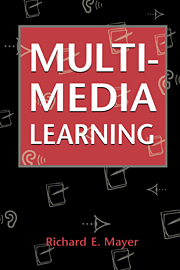Book contents
- Frontmatter
- Contents
- PREFACE
- 1 The Promise of Multimedia Learning
- 2 Multimedia Instructional Messages
- 3 A Cognitive Theory of Multimedia Learning
- 4 Multimedia Principle
- 5 Spatial Contiguity Principle
- 6 Temporal Contiguity Principle
- 7 Coherence Principle
- 8 Modality Principle
- 9 Redundancy Principle
- 10 Individual Differences Principle
- 11 Principles of Multimedia Design
- REFERENCES
- AUTHOR INDEX
- SUBJECT INDEX
10 - Individual Differences Principle
- Frontmatter
- Contents
- PREFACE
- 1 The Promise of Multimedia Learning
- 2 Multimedia Instructional Messages
- 3 A Cognitive Theory of Multimedia Learning
- 4 Multimedia Principle
- 5 Spatial Contiguity Principle
- 6 Temporal Contiguity Principle
- 7 Coherence Principle
- 8 Modality Principle
- 9 Redundancy Principle
- 10 Individual Differences Principle
- 11 Principles of Multimedia Design
- REFERENCES
- AUTHOR INDEX
- SUBJECT INDEX
Summary
Individual Differences Principle: Design effects are stronger for lowknowledge learners than for high-knowledge learners, and for high-spatial learners rather than for low-spatial learners.
Theoretical Rationale: High-knowledge learners are able to use their prior knowledge to compensate for lack of guidance in the presentation – such as by forming appropriate mental images from words – whereas low-knowledge learners are less able to engage in useful cognitive processing when the presentation lacks guidance. High-spatial learners possess the cognitive capacity to mentally integrate visual and verbal representations from effective multimedia presentations; in contrast, low-spatial learners must devote so much cognitive capacity to holding the presented images in memory that they are less likely to have sufficient capacity left over to mentally integrate visual and verbal representations.
Empirical Rationale: In two of three tests, low-knowledge learners achieved higher gains on retention tests from implementing multimedia design principles than did high-knowledge learners. In four of four tests, low-knowledge learners achieved higher gains on transfer tests from implementing multimedia design principles than did high-knowledge learners. In two of two tests, high-spatial learners achieved greater gains on transfer tests from implementing multimedia design principles than did low-spatial learners. There were not tests involving retention tests for high- and low-spatial learners.
QUESTIONS ABOUT MULTIMEDIA LEARNING
The first three chapters in this book examined the nature of multimedia learning – answering the question “What is multimedia learning?” – and described a cognitive theory of multimedia learning, aimed at addressing the question “Why does multimedia learning work?”
- Type
- Chapter
- Information
- Multimedia Learning , pp. 161 - 182Publisher: Cambridge University PressPrint publication year: 2001



